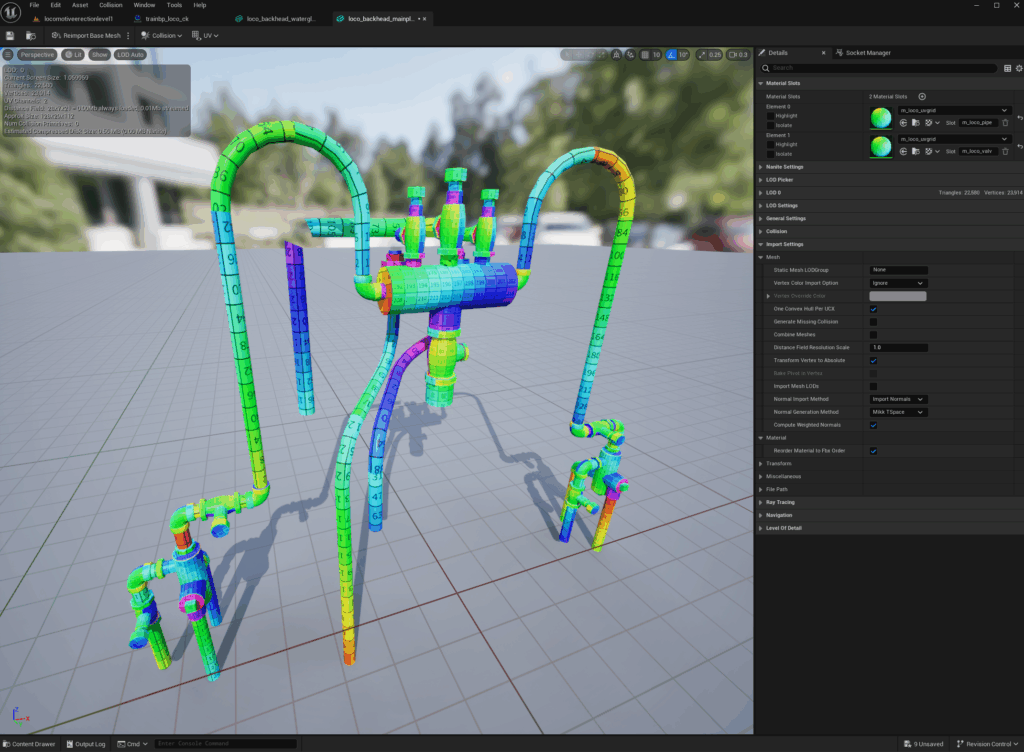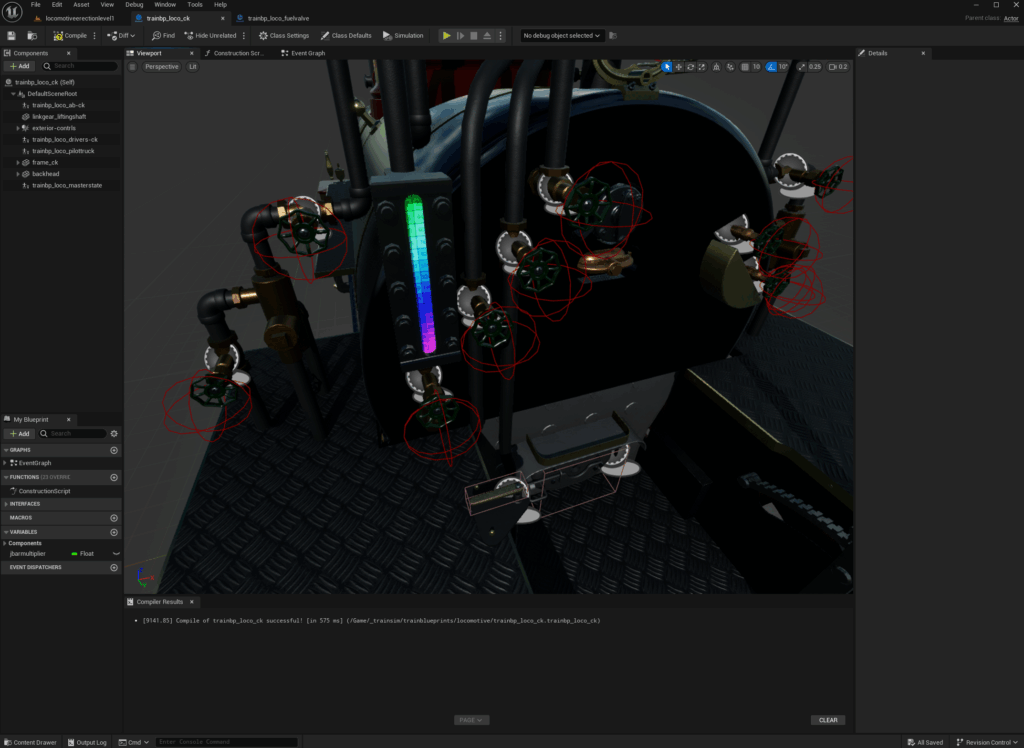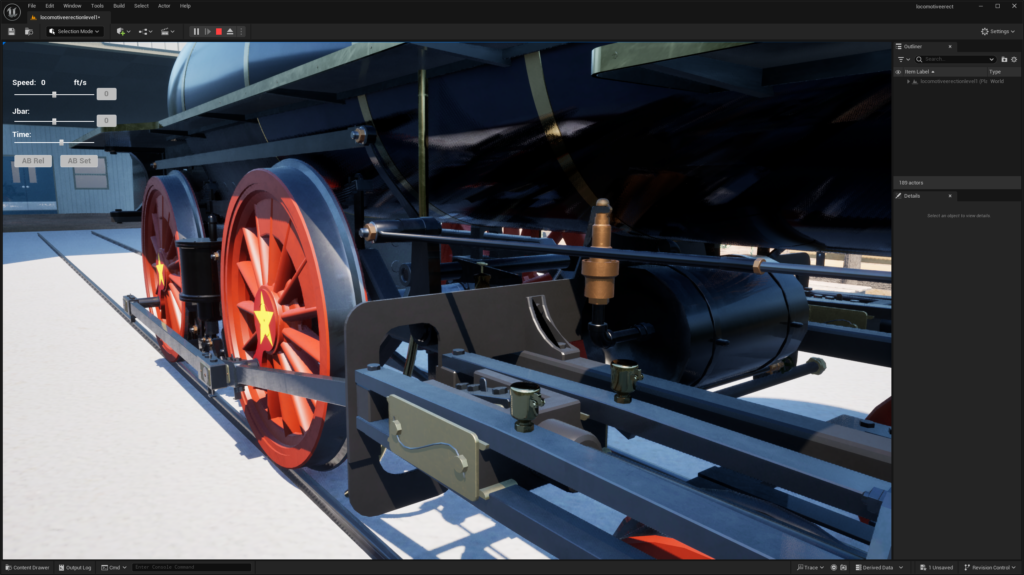Not much to say about it, just some modeling progress…







Not much to say about it, just some modeling progress…







Filed under Steam Engine Simulator
This is a first, but hopefully of many to come! Alex the Historian invited me to come along on his live stream of the Disneyland Railroad. We talked about the sim, DRR, and some progress on the new sim update!
Filed under Steam Engine Simulator
We’ve got a video, we’ve got a new video here!
See? Nobody cares.

But in case YOU do, check it out!
Let’s compare pictures also with the old model, which will make the improvements so very obvious. No further commentaries needed here, just steamy hot pictures.






















Now we’ll compare the meshes: Left side is new, right side is old. Despite the increase in modeling details, the mesh is much cleaner!



Next big items are the plumbing modeling, the backhead, the cab, and the coding of the firing dynamics, thermodynamics, physics, and plumbing/controls. Whew. But, I might take a break and finish the tender first.
Filed under CK Holliday build, Steam Engine Simulator
Here’s a small comparison between the old and the new model.
Below, the left (towards the front) is the old bell yoke, and the new one next to it is about to be finished. The difference in resolution and definition is obvious in the arms, but note also the small indentation in at the pivot, as well as the mounting bolts on the base of the yoke.

From all this, the new mesh also manages to be much cleaner than the old one still:

Filed under CK Holliday build, Steam Engine Simulator
Time for a quick post to just say that I am (and the current engine project) is still alive.
In this stage of the rebuild, the boiler is now being remodeled.
(To answer the incoming (and already asked) question: yes I did get the running gear to work! There’s QOL stuff I need to finish before showing it all off in a video.)


It doesn’t look like much but the model has a lot more definition. In the shot above, the old (v1) model is on the left, and the rebuild on the right.
And, in the shot below, the old one is also on the left and the new one on the right. On the smokebox front, where there is more detail, it’s obvious that the new model is just much “cleaner”, which will result in better detail and performance. The new model even have washers and pins on the smokebox door swing!

And here are some import tests into UE5. The model hasn’t been mapped/textured and there’s plenty of little details to add, but the “outline” of the boiler is there.



I’m contemplating whether the stay bolts on the firebox should be modeled or textured for this build. For reference, they’re textured in v1, which means they get blurry when you get close to them.
My goal is to finish refining the running gear and the boiler before the next video, so yes I have updates and features planned. It’s a long road but I think if and when finished it’s going to be a simulation unlike any others, even the current v1 DRR Sim!
Filed under CK Holliday build, Steam Engine Simulator
Let’s take a look at the progress (or the lack of progress) of the engine link and valve gear animation!
It looks great in Blender so far, until we get into UE5 and suddenly it’s a lot more complicated.
While I ramble about making this all work out “for the next version of the simulator”, don’t take this as any kind of announcement or hints. The “next version of the simulator” is still only a dream at this point, but sometimes dreams do come true!
Filed under CK Holliday build, Steam Engine Simulator
The new store is here and you can make purchases as usual (at the moment only the Sim and the digital plan book are available…nothing new to add to the store yet).
If there are any troubles please let me know! As it’s a new store there certainly could be bugs.
Now that’s done, hopefully I will have time to make another video update of the rebuild soon!
Filed under Steam Engine Simulator
Sales of all products on the ckhollidayplans.com, including the simulator and plan book, are currently on paused as we’re looking for a new distribution platform. Sorry for the inconvenience!
Please note also that if you’ve bought the Sim previously, your copy will continue to work, but you won’t be able to redownload it from Fastspring anymore.
Filed under Steam Engine Simulator
Once every “few” years at the Disneyland Railroad, an engine goes off to a locomotive shop for a rebuild. The engine is taken apart, every component inspected, and either get refurbished or replaced new. With the sim being almost 6 years old now, I started to wonder if I could rebuild my own CK HOLLIDAY, using the current generation graphics engine.
Well, I did started the rebuild, and here’s a preview of it so far:
If you’re wondering what the real rebuild is like, I covered the last CK Holliday rebuild back from 2015-2016 here:
My rebuild is based on the the study model, using it as a template. It is so far all new, with new model and components made from scratch. Hopefully, we’ll cover this aspect of the build in more detail. For now, enjoy the video walk around!
Filed under CK Holliday build, Steam Engine Simulator
Here it is! A basic overview of how to fire.
By “basic” I mean exactly that. There are more advanced ways and techniques to fire, also the engine is stationery which helps with learning the basics!
Filed under Steam Engine Simulator